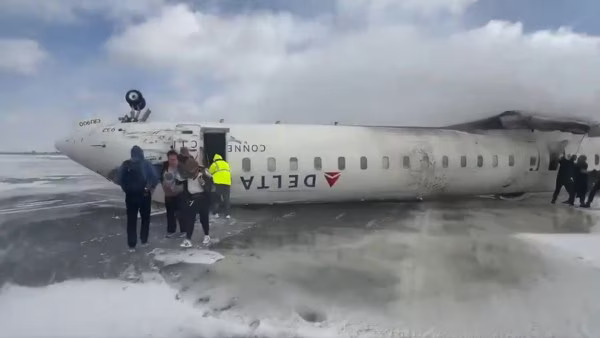Chaos at Toronto Pearson: Delta Airlines Plane Crash-Lands Upside Down, Leaving 18 Injured—3 in Critical Condition!

In a shocking turn of events at Toronto Pearson International Airport, a Delta Airlines flight crash-landed and ended up upside-down, raising fresh concerns about aviation safety. The terrifying incident, which occurred on Monday, fortunately did not result in any fatalities. However, 18 passengers—including a child—sustained injuries, as confirmed by Peel Regional Paramedic Services. Despite the harrowing ordeal, all onboard managed to escape with their lives, making this a miraculous survival story amidst ongoing aviation mishaps.
What saved the passengers in Delta Airline Crash?
Experts believe that a combination of advanced engineering, the aircraft’s structural integrity, and the proper use of seatbelts played a crucial role in saving the passengers. The plane’s design is built to withstand severe impacts, while its size helped absorb the shock of the crash. Additionally, passengers who had their seatbelts securely fastened were better protected from sudden jolts and potential injuries. These factors, along with the quick response of emergency teams, contributed to the miraculous survival of everyone onboard.
Mike McCormick, an associate professor and program coordinator for air traffic management at Florida’s Embry-Riddle Aeronautical University, explained to USA Today that it’s highly unusual for planes to flip upside-down. However, aircraft are specifically engineered to endure such rare scenarios. This remarkable design ensures that even in the most unlikely and extreme situations, planes are capable of withstanding the forces involved, ultimately contributing to the safety of those onboard.
According to McCormick, the seats on aircraft are built to withstand forces up to sixteen times the force of gravity, ensuring they remain secure even in the event of a tip-over. This design is one of the key reasons passengers are always instructed to fasten their seat belts during takeoff and landing. “As long as there are no loose items flying around the cabin, the seats are engineered to keep passengers safely strapped in,” McCormick explained. This thoughtful design helps protect passengers from the intense forces that can occur during unexpected situations.
The aircraft’s design includes structural features that allow the wings and tail to detach if the plane flips upside down, ensuring the safety of those onboard, McCormick explained. Additionally, the trained cabin crew plays a critical role in handling such emergencies. They’re not just there for refreshments and inquiries—they’re specially trained to make quick, calculated decisions to protect passengers. McCormick emphasized this during his interview with USA Today, highlighting the true value of the crew’s training in moments like these. Visuals from the Delta Airlines crash show the crew efficiently evacuating passengers after the incident.
Another key safety factor is the small size of the Bombardier CRJ900 aircraft. Aviation expert Arnold Barnett pointed out that the aircraft’s relatively low cabin height—just around 6 feet—meant passengers wouldn’t fall far during the tip-over, which likely minimized injury risk.
Lastly, Hassan Shahidi, President and CEO of the Flight Safety Foundation, praised the quick actions of first responders at the airport. They were instrumental in helping evacuate passengers and applying fire-resistant foam to the aircraft, which helped prevent a potential fire after the crash, demonstrating a swift and effective response to an emergency situation.